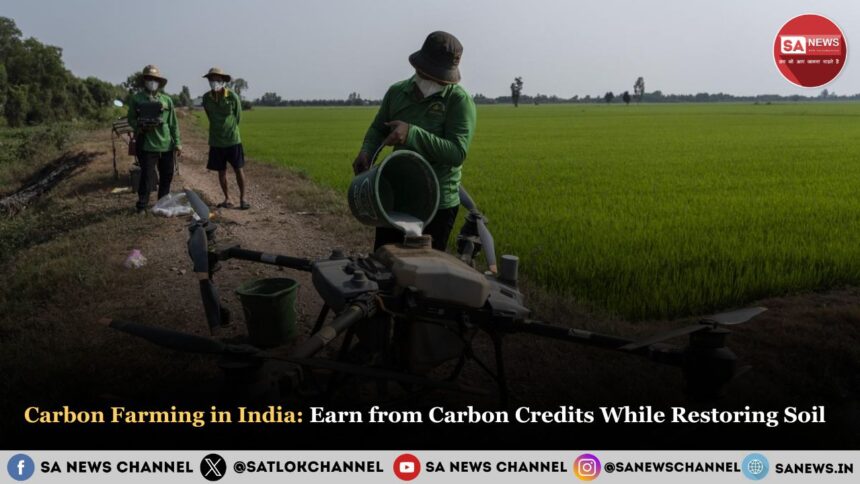Global warming is one of the most critical problems facing the Earth today. The rise in global temperatures is mainly due to an increase in the concentration of greenhouse gases in the atmosphere. Greenhouse gases are gases in the Earth’s atmosphere that trap heat. Agriculture is one of the significant sources of carbon dioxide (CO₂) and other greenhouse gas emissions. However, this can be changed by adopting carbon farming. Instead of being a source of greenhouse gas emissions, agriculture can become a carbon sink.
- Meaning of Carbon Farming
- Practices of carbon farming
- Benefits of carbon farming
- Challenges of carbon farming
- Methods for carbon farming
- Process of carbon credit farming
- Initiatives taken by Indian Government on carbon farming and sustainable agriculture
- Spiritual Perspective: Balance through Satgyan
- FAQs About Carbon Farming
- Connect With Us on the Following Social Media Platforms
Meaning of Carbon Farming
Carbon farming is an approach that includes a range of practices mostly aimed at removing CO₂ from the atmosphere through photosynthesis and storing it in soils, plants and other organic materials. Many of these practices such as cover cropping, reduced tillage are already common to organic and regenerative Agriculture.
Also Read: From Traditional Farming to Smart Agriculture: A Tech-Driven Transformation
Practices of carbon farming
1. Reduced tillage:
It involves minimum soil disturbance using minimum or no tillage. It supports beneficial soil organisms, improves soil infiltration rate and also protects soil from erosion.
2. Reduced fertilizer application:
Nitrogenous fertilizers are essential for food security, but they contribute about 5% of greenhouse gas emissions. Therefore, it is necessary to use them in reduced amounts.
3. Cover cropping:
Unlike traditional cash crops, cover crops are cultivated primarily to improve soil health.
4. Improved crop residue management:
Another soil health strategy in carbon farming is to leave crop residue in the fields. Covering the soil with mulch or crop residue materials like straws, enhances soil fertility while allowing the organic material to interact with microorganisms for healthier soil composition.
5. Eliminating bare fallows:
Leaving soil exposed without any protection from heat, wind, rain and weeds will allow soil carbon to escape more readily.
6. Agroforestry:
Farming with the intentional integration of trees with agriculture is known as agroforestry. Agroforestry practices can help mitigate emission and store carbon in both soils and trees. It also enhances farm productivity, increases soil protection, improves air and water quality, provides wildlife habitat and introduces diversified income.
Benefits of carbon farming
Carbon Farming not only helps mitigate climate change but also offers numerous co-benefits including improved soil health, better water retention and increased biodiversity.
1. Improved soil health:
Carbon- rich soils have improved structure and fertility, promoting high yields and reducing emission risks.
2. Water efficiency:
Better soil structure increases water retention, which means improved irrigation efficiency and potential cost savings.
3. Use of crop residue:
Carbon Farming practices encourage use of more efficient and sustainable use of crop residue, basically turning trash into treasure, lessening the need for chemical inputs and minimizing ecological hazards.
4. Biodiversity support:
Carbon sequestration farming practices promote beneficial soil microorganisms.
5. New revenue streams:
Farmers can generate extra income by selling carbon credits to organizations.
6. Reduced input costs:
Improved soil health and water retention can decrease the need for fertilizers and irrigation, leading to significant cost savings over time.
7. Sustainable land management:
Carbon Farming practices contribute to long term land health, preserving farm value and productivity for future generations.
Challenges of carbon farming
The potential challenges of carbon farming are,
1. Economic:
The cost of adopting carbon farming practices is high.
2. Technical constraints:
Lack of information and technical skills in farmers. Inadequate extension.
3. Policy and institutional barriers:
Weak institutional support for monitoring and verification of carbon sequestration efforts. Inadequate policy frameworks.
4. Market barriers:
Undefined market mechanisms for trending in carbon credits and insufficient infrastructure for linking farmers to carbon markets.
Methods for carbon farming
1. Forest management:
Forests absorb and hold CO2 emissions produced from automobiles, industries and other sources.
2. Grassland conservation:
It maintains native life of plants through permanent land conservation
3. Mixed farming:
It is a good practice to grow several species of crops on the farm along with one or more livestock units.
4. Cover crops:
Crops planted to cover the soil. Cover crops help to return more carbon to soil and sustain soil microbes that store carbon.
5. Reducing soil tillage:
Tillage can cause the loss of a significant amount of carbon. The exposure of soil organic carbon to aeration during soil erosion increases CO2 emission.
6. Wetland restoration:
Wetlands are crucial carbon sinks, absorbing and storing vast amounts of carbon dioxide. Wetlands like peatlands, mangroves, and seagrass beds are among the most efficient carbon sinks on Earth, absorbing and storing more carbon than all the world’s forests combined.
Process of carbon credit farming
There are several key stages that must be completed by farmers for receiving payment for carbon credits.
Here is a step by step guide about carbon credits for farmers focused on entering the specialized market and obtaining credits.
1. Find a carbon project developer:
Farmers usually start by locating a project developer who guides them through the buying and selling process.
2. Provide farm information:
Then, farmers share basic details about the farm, including current practices, future plans and location of fields.
3. Initial estimation:
The project developer uses farmer’s data to estimate how many CO2 offsets a farm could potentially generate.
4. Implement Regenerative Practices:
Farmers adopt additional regenerative farming practices, such as cover cropping or reduced tillage, that enhance soil organic carbon ( SOC ) sequestration.
5. Data Collection and Monitoring:
After a year or so, data on the effects of practices on the farm can be gathered and analysed to assess the amount of SOC sequestered.
6. Third – party Verification:
Third party agent is an expert who collects, analyzes, and verifies the farm’s data. To ensure accuracy, they might conduct a site visit or use remote sensing technology. The verifier calculates the number of CO2 offsets earned.
7. Sell Carbon Credits:
Once verified, carbon offsets can be sold on the voluntary market, providing farmers with a new revenue stream.
Initiatives taken by Indian Government on carbon farming and sustainable agriculture
Indian Government has undertaken several initiatives on carbon farming and sustainable agriculture as follows:
1. National Mission for Sustainable Agriculture (NMSA)
It has taken up climate resilient agricultural practices to sustain agriculture. This deals with soil health management and efficient utilisation of water.
2. Paramparagat Krishi Vikas Yojana (PKVY):
This would include financial support and training for farmers to go organic, which is the very essence of carbon farming.
3. Soil Health Card Scheme:
The card will carry information regarding the soil health status and provide suggestions for improving soil quality. So indirectly, carbon farming practices get encouraged.
4. Green India Mission:
It is a sub-mission under NAPCC that aims for enhancing carbon sequestration through planting and afforestation activities.
5. National Agroforestry Policy:
Achievements endorsing trees on farms integration to enhance carbon sequestration, besides offering supplementary income to farmers.
Spiritual Perspective: Balance through Satgyan
Carbon farming restores nature, but true harmony comes from inner change. According to Sant Rampal Ji Maharaj, environmental crises reflect a loss of spiritual wisdom (Satgyan). When human actions are guided by truth, compassion, and discipline, nature responds positively.
Just as carbon farming heals the earth, Satgyan heals the soul—both are vital for a truly sustainable future.
FAQs About Carbon Farming
1. What is meant by carbon farming?
Ans. Carbon Farming is the system of Agricultural management that helps the soil and vegetation to store more carbon.
It is also known as “carbon sequestration”.
2. What is the use of carbon farming?
And: Carbon farming is used to remove carbon dioxide from the atmosphere and convert it into plant material and soil organic matter. Also, carbon farming reduces greenhouse gas released during agricultural processes in the atmosphere.
3. Which is the first state in India to work on zero carbon?
Ans. Himachal Pradesh is the first state to take steps towards carbon neutrality in 2009.
4. What is the price of 1 carbon credit in India?
Ans. According to recent reports, the carbon credit price in India typically ranges from 300 to 600 rupees per tonne.
5. Can farmers make money from carbon farming?
Ans. Yes, carbon farming can generate income by creating carbon credits.









